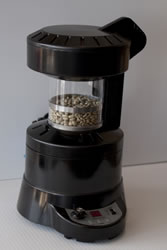Home Coffee Roaster User Guides
Fresh Roast SR500 Roasting Guide

Thank you for checking out our Fresh Roast SR500 roasting guide. Here are the basic steps:
- Start with four level scoops of green coffee (about 4.5 ounces by weight).
- Remove the chaff collector, add the coffee to the roasting chamber and put the chaff collector back on.
- Toggle the heat setting from OFF to LOW. Set the timer for 5 – 9.9 minutes. You may add time at any point by hitting the UP button.
- Start the roast with a low temperature setting and the highest fan speed to lower moisture content and ensure an even roast. After approximately two minutes set the temperature to high. As the roast progresses coffee beans will begin turning over vigorously, especially after first crack, turn the fan speed down to build heat and limit bean-chipping.
- As coffee beans roast they will begin to brown, double in size and separate from there chaff, emitting a light audible crack, this is called “first crack”. Now you’re starting to watch for your desired roast. We recommend a coffee roast that is dark brown, right before second crack, when the beans turn from dull/flat color to having a slight sheen on the exterior; this is a full-city roast. If you see oil on the surface, you are into the second crack.
- “Second crack” occurs when internal bean oils and moisture expand from an exothermic reaction, producing a small hole on the bean and emitting a light audible crack similar to popcorn popping; this is the start of a dark roast. If you see smoke coming from the roaster you are getting into the second crack and at a dark roast, if you’ve gotten to this point you want to hit the COOL button.
- After the cool cycle shuts off, remove the chaff collector (be careful – the roaster is still pretty warm), lift out the roast chamber by its handle and dump the beans. You should dump the freshly roasted beans in a glass or ceramic bowl and let them set-up for a day or two before putting them in an air tight container. We like to store the set-up roasted beans in a small canning jar.
The only cleaning necessary is to dump out the chaff from the chaff collector and wipe the collector out, I use a small basting brush to clean. This model yields about 28 cups per batch.
What if your roasts are too dark or too light? Batch size is critical to the roasting process. In all air roasters, smaller batches take longer to roast and larger batches roast faster. It may seem counter-intuitive, but hot air flows more freely with fewer beans giving less chance for heat to build up in the chamber. If your roasts are too dark decrease your batch size to increase air flow or hit the COOL button earlier. If your roasts are too light increase your batch size to increase trapped hot air or increase time and heat settings.
More Roaster Use Notes:
All roasters are sensitive to your home voltage, so it helps to roast on a circuit that is not being used at the same time you are roasting. The time setting may vary so be sure and watch carefully, especially with a new roaster.
Keep in mind that these are home roasters, not commercial roasters, you will need to let them cool down between batches or you may trigger the thermal protection which requires the roaster to be reset by the manufacturer and may void the warranty.
Never leave the roasters unattended. Home coffee roasting is similar to frying bacon on your stovetop, it can and will burn if left unattended. If you want to stop the roast at any time, just hit the COOL button. Don’t turn it to off, the roasters are quite hot and require a cool cycle before handling.
See our Video Post & Tips on using the FreshRoast SR500 Home Coffee Roaster
Go to the Fresh Roast SR500 product page for information on pricing and current deals.


